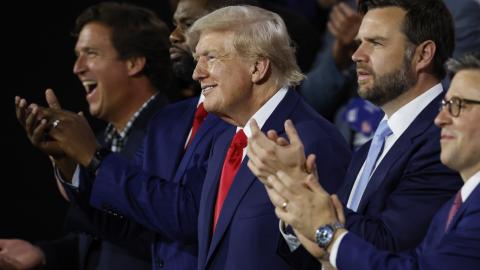It has been almost fifty years since the U.S. government decided to emblazon In God we trust on the nations paper currency. Thats more comforting to some than In markets we trust, but somewhat less accurate, now that the Bush administration has abandoned the so-called strong dollar policy of his predecessor. If anything about the Bush administrations economic policy is clear, it is that jobs are the number one priority, the word jobs being the politic translation of the real priority, reelection of George W. Bush.
The president faces a difficult campaign in which he is already being accused of destroying more jobs than Herbert Hoover, president during the onset of the Great Depression. In key states such as Ohio, Illinois, and Michigan, many voters are convinced that it is Bushs fault that they are out of work because their jobs have been exported to China and other low-wage climes.
Until now, the president has been counting on his tax cuts to revive the economyand he has been right. What he didnt count on was that even current robust growth wouldnt create the number of new jobs generally produced at this stage of a recovery.
With the Democrats turning protectionist, the trade deficit mounting, and China and India now competing successfully in markets for high-tech products, the administration has decided that a cheaper dollar is one answer to its problems. American goods are becoming cheaper overseas, and chemical giant Dupont is already saying that increased exports are leading to significant new hires.
Whether the dollar has fallen far enough to stimulate exports, cut imports, and add to job creation is uncertain. But one thing does seem certain: that there is nowhere to go but down. To understand why, consider whether it is likely that any of the developments that might halt the dollars descent are likely to occur.
The most obvious reason for the fall in the dollar is Americas trade deficit. We send the world our bits of paper, they send us their goods and services. As our trading partners pile up more and more of our dollars, they become less enthusiastic about accumulating still moreunless the price drops, enough to make the bits of paper more attractive to buy, but not so much as to threaten a continued precipitous fall that would dictate dumping dollar holdings.
Eventually, the dollar will fall to a point where the trade deficit starts to look more manageable. But so long as our two important trading partners, China and Japan, refuse to allow the dollar to fall sharply relative to their own currencies, their goods will seem cheap here, and American products expensive in their markets. That will force the dollar to keep dropping, to a point well below that which would prevail in a truly free currency market.
The descent of the dollar could also be slowed, and eventually halted, if the Federal Reserve Boards monetary policy gurus would raise interest rates. That would make dollar assets even more attractive to foreigners, and increase their demand for the dollars needed to buy those assets. But the Fed has announced that it will be patient before raising interest rates. So no upward pressure on the dollar will come from the Fed.
Another possibility is that the European Union would cut the U.S. trade deficit by adopting reforms to stimulate now-moribund European domestic demand. The European Central Bank could lower interest rates and end its ridiculous efforts to force recession-ridden countries to raise taxes or cut spending, and the German and French governments could reduce incentives to remain on the dole rather than work. That would put money into the pockets of Europes consumers, enabling them to buy more made-in-America products, cutting the U.S. trade deficit, and reducing the downward pressure on the dollar. But it wont happen.
Finally, the president and the congress might agree to attack the federal deficit, now crowding an astonishing 5 percent of GDP. But Bush has decided to have guns, butter, tax cuts, an expanded welfare state, and a trip to Mars, while the Democrats want to end some of the tax cuts that benefit the rich, and spend less on guns, but only so that they can spend more on education, health care, roads, and anything else that might attract a vote or two. So, as with Eurloland reform, when it comes to trimming the federal deficit, that old New York phrase, fuggedaboutit, about summarizes the prospects.
That means that the federal budget will continue to stimulate growth in America, which in turn means that our demand for the goods of the world will remain strong, our trade deficit high, and our currency weak.
For Bush, a weakening dollar is far preferable to the protectionist measures the Democrats are calling for. John Kerry, the Massachusetts senator and leading contender for the Democratic Partys presidential nomination, once voted for the North American Free Trade Agreement (NAFTA). That was before the pestilent presidential bug bit. Kerry now says that it is unpatriotic for American companies to shift jobs overseas, that corporate taxes should be higher for such companies than for patriotic companies, and that we should insist that our trading partners raise their labor and environmental standardsread, coststo our own. That, of course, would end the cost differences that make international trade so wealth-creating and efficient.
So decline the dollar may. But it wont collapse. Foreigners still want to put their money into dollar assets. The U.S. Treasury reported last week that net capital inflows from foreigners averaged $59 billion per month last year, up from $48 billion in 2002, and more than enough to cover the dollar outflows associated with the trade deficit. The dollar may not be as mighty as it once was, but it is far from puny.
This article appeared in Londons Sunday Times on February 22, 2004.



















